|
|
Updated as per James P. Tuttle's The Hawk Moths of North America, August 25, 2008
|
Crook County, Oregon
Sphingidae Larvae
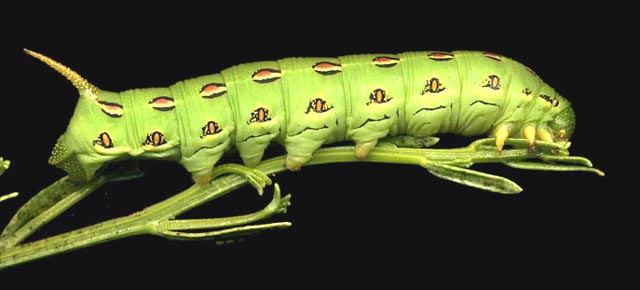
Hyles lineata, courtesy of David Bygott
For care of "found larvae/caterpillars" visit Manduca sexta larva, central Texas, August 21, 2008, Trina Woodall.
Only twenty-three Sphingidae species are listed for Oregon on the U.S.G.S.
website. Not all of the species are reported or anticipated in
Crook County (Seven are reported on U.S.G.S. as of August 25, 2008).
It is hoped that this checklist, with the thumbnails
and notes, will help you quickly identify the larvae you are likely to
encounter.
A "WO" after the species name indicates that
I have no confirmed reports of this species in your county, but I
(William Oehlke) expect that this moth with its larvae are present or
might be present.
A "USGS" indicates the
moth is reported in Lepidoptera of North America,
#1. Distribution of Silkmoths (Saturniidae) and Hawkmoths (Sphingidae)
of Eastern North America,
an excellent little booklet available through Paul Opler.
Please help me develop this list with improved, documented accuracy by
sending sightings (species, date, location), preferably with an
electronic image, via email to
Bill Oehlke.
Sphinginae subfamily
Sphingini tribe:
 |
The caterpillars are called Tomato Hornworms and each has a black horn at the end of the abdomen.
Larvae feed on potato, tobacco, tomato, and other plants in the
nightshade family (Solanaceae).
|
 |
Sphinx chersis
WO, the Northern Ash Sphinx or Great Ash
Sphinx:
The larvae are pale bluish green. The head has a pair of yellow
lateral bands meeting at the apex. The oblique, lateral stripes are
pale and bordered anteriorly with a darker green.
Larval hosts are ash, lilac, privet, cherry, and quaking aspen.
|
 |
Larvae hide in the day and feed primarily on cherry, plum, and apple
at night. Larvae have been found on Amelanchier nantuckensis
in Massachusetts and have been reared to pupation in Michigan on
Prunus serotina. Note purple oblique lines.
|
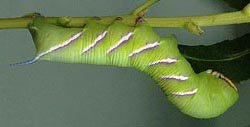 |
Sphinx perelegans
USGS, the
Elegant Sphinx:
The basic body colour can be either glaucous or apple-green, without the earlier body tubercles. The oblique side stripes are white,
edged with purple.
The horn is sky blue. The spiracles are pale orange and the anal flap is edged with yellow.
|
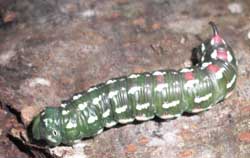 |
Larvae feed on California juniper (Juniperus californica) and Rocky Mountain juniper (J. osteosperma).
|
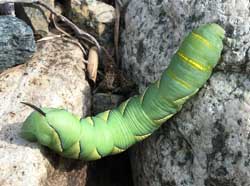 |
Sphinx vashti
USGS,
the Snowberry Sphinx
Larvae feed on the common snowberry (Symphoricarpos albus)
and on coralberry (S. orbiculatus). Note the two golden
lines of slightly raised bumps, one just behind the head, the other
on the thorax.
|
Smerinthini Tribe:
 |
Pachysphinx modesta
USGS,
the Modest Sphinx or Poplar Sphinx
Larvae feed on poplars and cottonwood.
The anal horn is greatly reduced in the final instar.
|
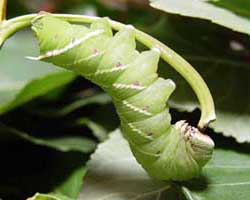 |
Larvae feed on cottonwood and poplar (Populus) and willow
(Salix).
Larvae are very chunky with little to distinguish them
from Pachysphinx modesta.
|
 |
Larvae accept willows, birches, and cherries.
I have also found them in the wild on oak in eastern Canada.
Skin is quite granulous.
|
 |
Wild cherry species are the favorites as larval foodplants, but eggs
will also be deposited on birches and other forest trees.
There are varying degrees in the amount of red markings along the sides.
|
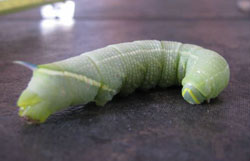 |
Smerinthus ophthalmica
WO:
Ophthalmica larvae resemble cerisyi larvae, both being pale
green, with granular skin, pale lateral diagonal lines, faint red
spiracular circles, and very pale longitudinal lines running from
head to more pronounced anal diagonal line.
Larvae have green heads bounded dorsally with pale yellow
inverted "V". Note blue horn.
|
Macroglossinae subfamily
Dilophonotini tribe:
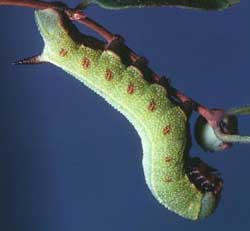 |
Larval host plants include Snowberry (Symphoricarpos),
honeysuckle (Lonicera), Coralberry, viburnums, high bush cranberry and hawthorn (Crataegus).
Horn is black with a slightly lighter base. This western species was formerly classified as
H. diffinis or H. senta. Those species west of the Continental Divide are now classified as
H. thetis.
|
Macroglossini tribe:
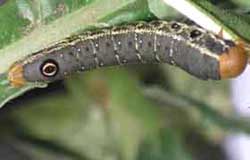 |
Arctonotus lucidus
WO, the Pacific Green Sphinx or Bear Sphinx
Larvae feed on evening primrose (Oenothera dentata var. campestris) and
clarkias. David Wikle fed them on both Mexican evening primrose, Oenothera berlandieri and evening primrose, Oenothera biennis.
Earlier instars are green. Eye at dorsal posterior appears in fifth instar.
|
 |
Hyles gallii
WO, the Bedstraw Hawk Moth
or Gallium Sphinx
This species is not reported in Chippewa, but it has been recorded in
eastern Wisconsin counties. I suspect it is present.
Larvae come in black and in brown forms and often feed on
Epilobium (fireweed).
|
 |
Hyles lineata
WO, the White-lined Sphinx
Larvae are highly varied and feed on a great diversity of plants
including willow weed (Epilobium), four o'clock (Mirabilis),
apple (Malus), evening primrose (Oenothera), elm
(Ulmus), grape (Vitis), tomato (Lycopersicon),
purslane (Portulaca), and Fuschia.
All larvae seem, however, to have the red/black swellings split by
dorso-lateral lines.
|
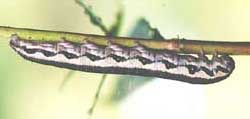 |
Larvae feed on elegant fairyfan (Clarkia unguiculata) in the evening primrose family (Onagraceae).
|
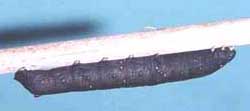 |
Larvae feed on willow weed (Epilobium) and possibly thimbleberry (Rubus parviflorus).
|
|
|
Use your browser "Back" button to return to the previous page.
This page is brought to you by
Bill Oehlke and the
WLSS. Pages are on space rented from Bizland. If you would like
to become a "Patron of the Sphingidae Site", contact Bill.
Please send sightings/images to Bill. I will do my best to respond to
requests for identification help.
Enjoy some of nature's wonderments: Saturniidae cocoons.
Cocoons of the giant silkmoths may be purchased in the fall and winter. Big and beautiful giant silk moths will emerge in spring/summer.
Read Actias luna rearing article. Additional online help available.
This website has been created and is maintained by Bill Oehlke without government or institutional financial assistance. All expenses, ie., text reference
support material, webspace rental from Bizland, computer repairs/replacements, backups systems, software for image adjustments (Adobe Photoshop; L-View),
ftp software, anti-virus protection, scanner, etc. are my own.
I very much appreciate all the many images that have been sent to me, or of which I have been granted permission to copy and post from other websites.
All images on this site remain the property of respective photographers.
If you would like to contribute to the maintenace of this website by sending a contribution to
Bill Oehlke
Box 476
155 Peardon Road
Montague, Prince Edward Island, C0A1R0
Canada
your donation would be much appreciated and would be used for
1) paying for webspace rental;
2) paying for computer maintenance and software upgrades;
3) purchases of additional text reference material (journals and books) in anticipation of expanding the site to a worldwide Sphingidae site;
4) helping to pay my daughter's tuition; with anything left over going to humanitarian aid.
If you are mailing a check from USA, please use $0.85 postage. Donations can also be made through Paypal via the button below.
